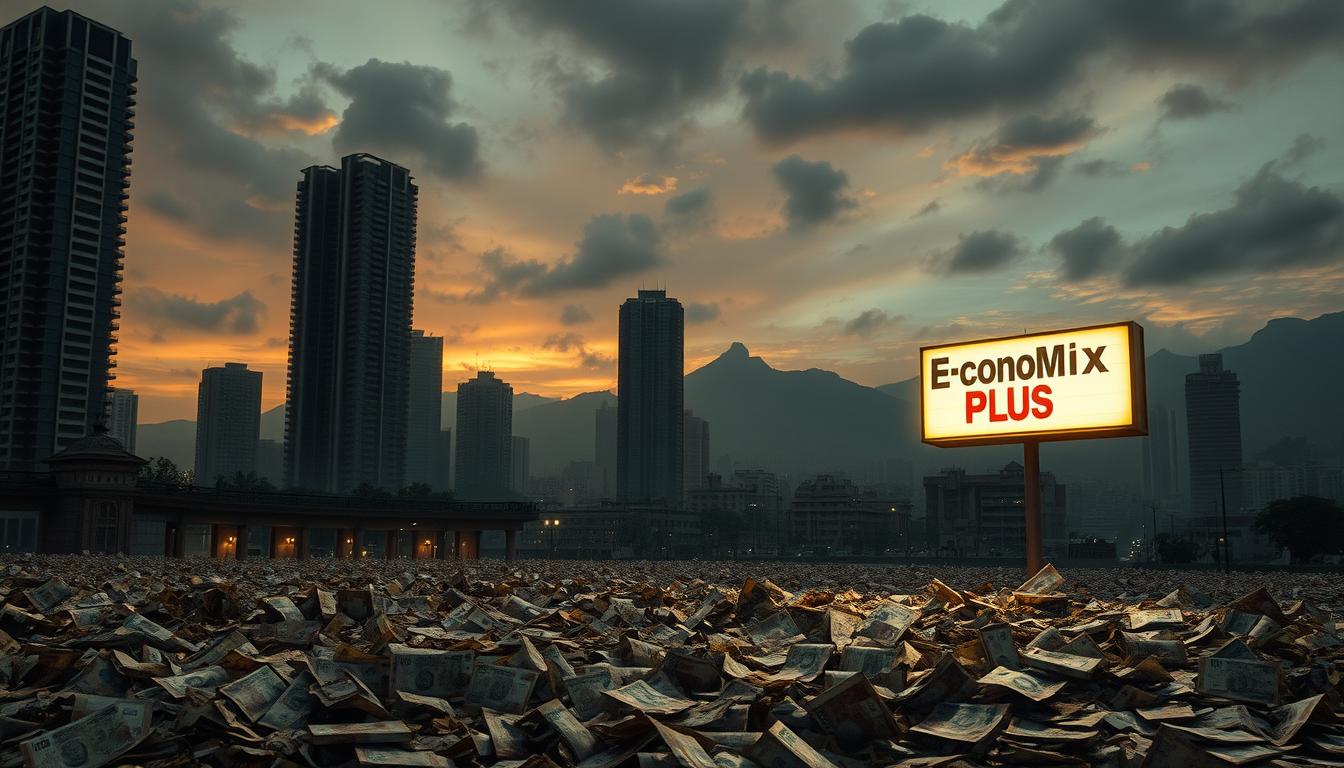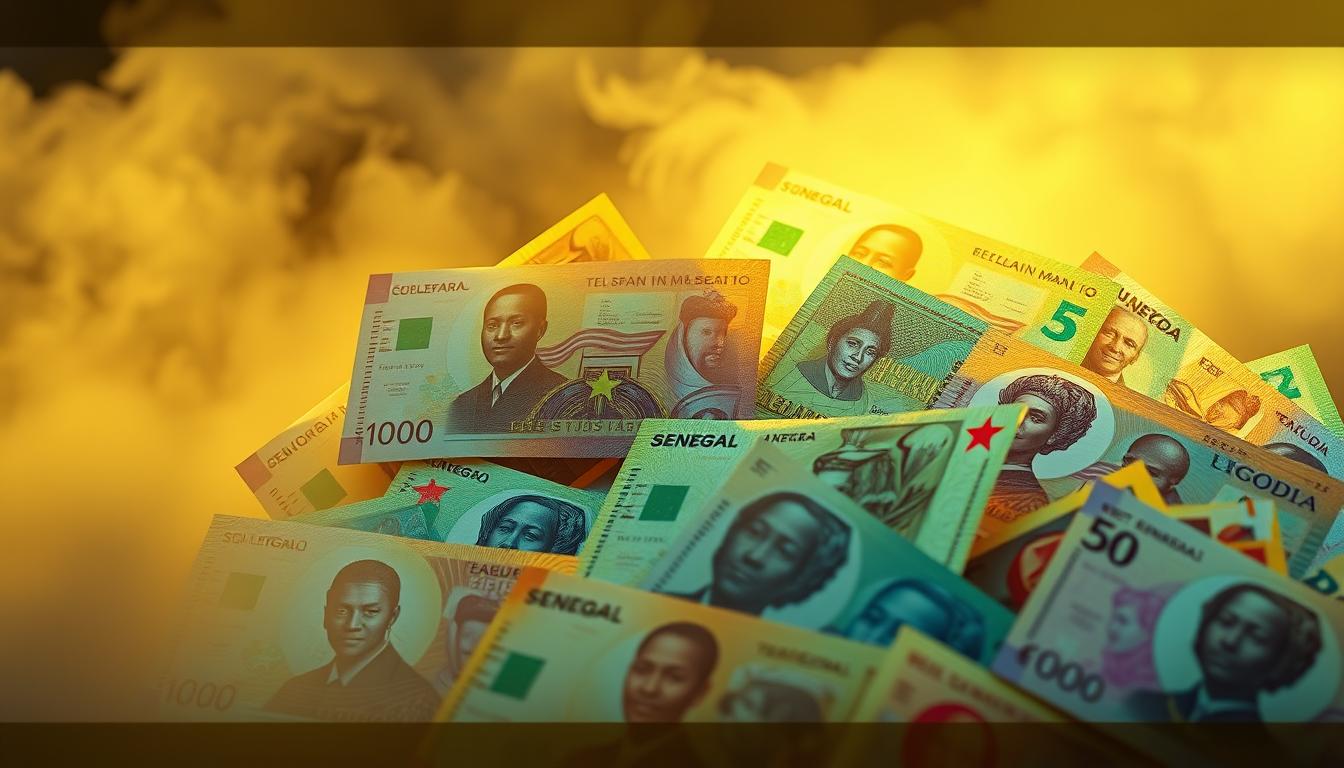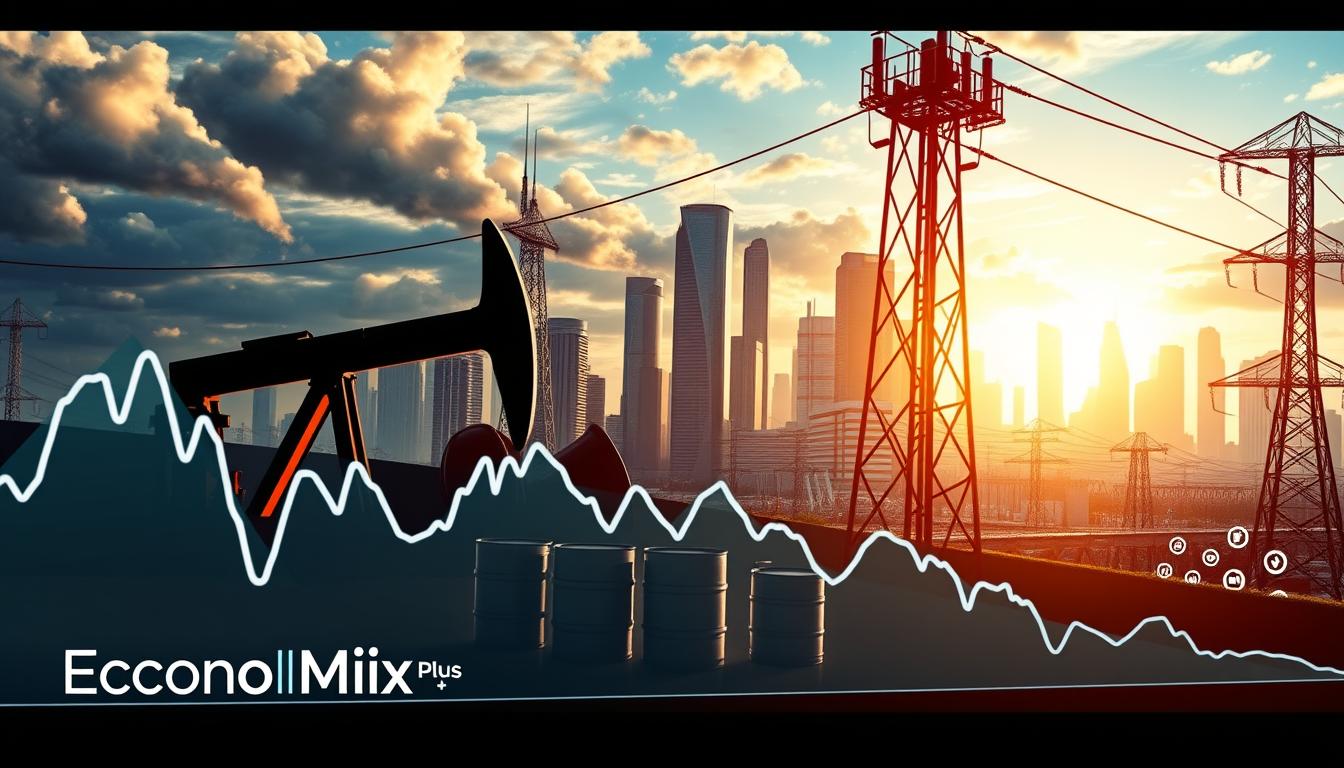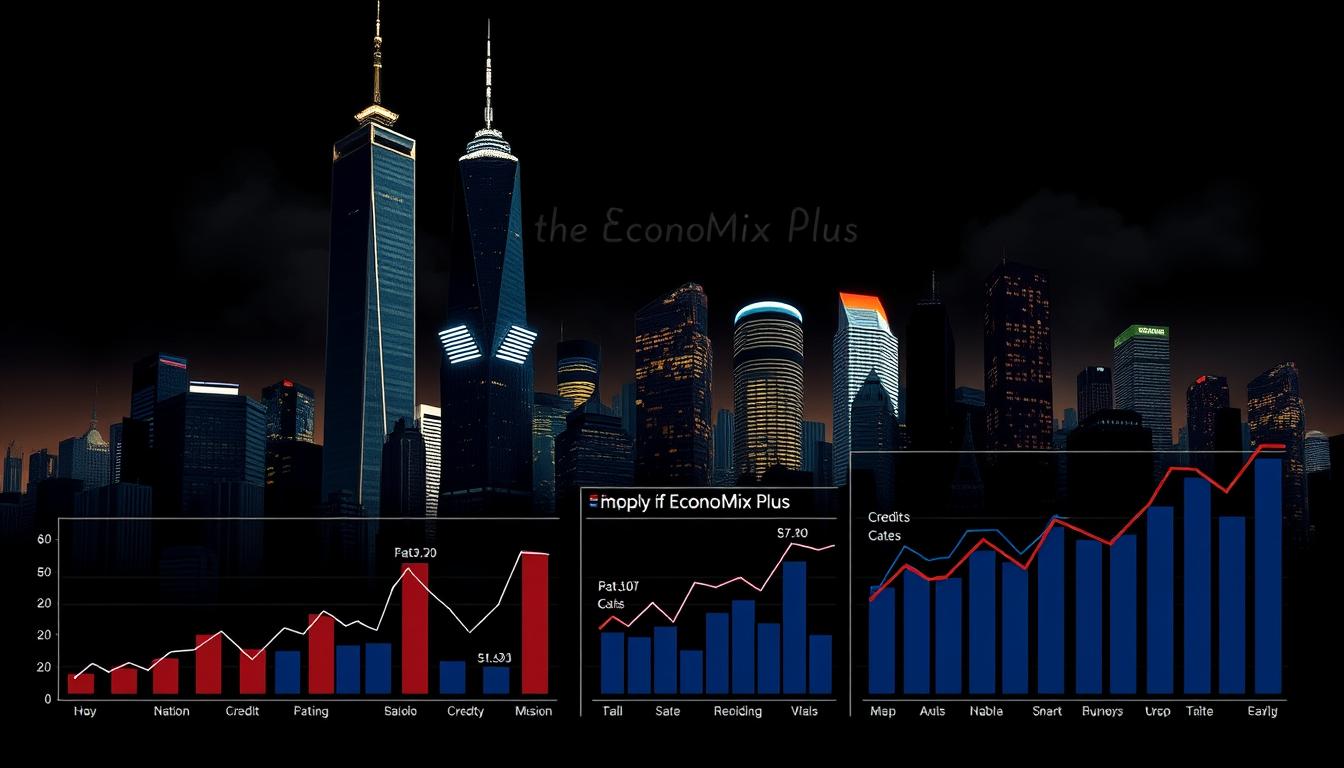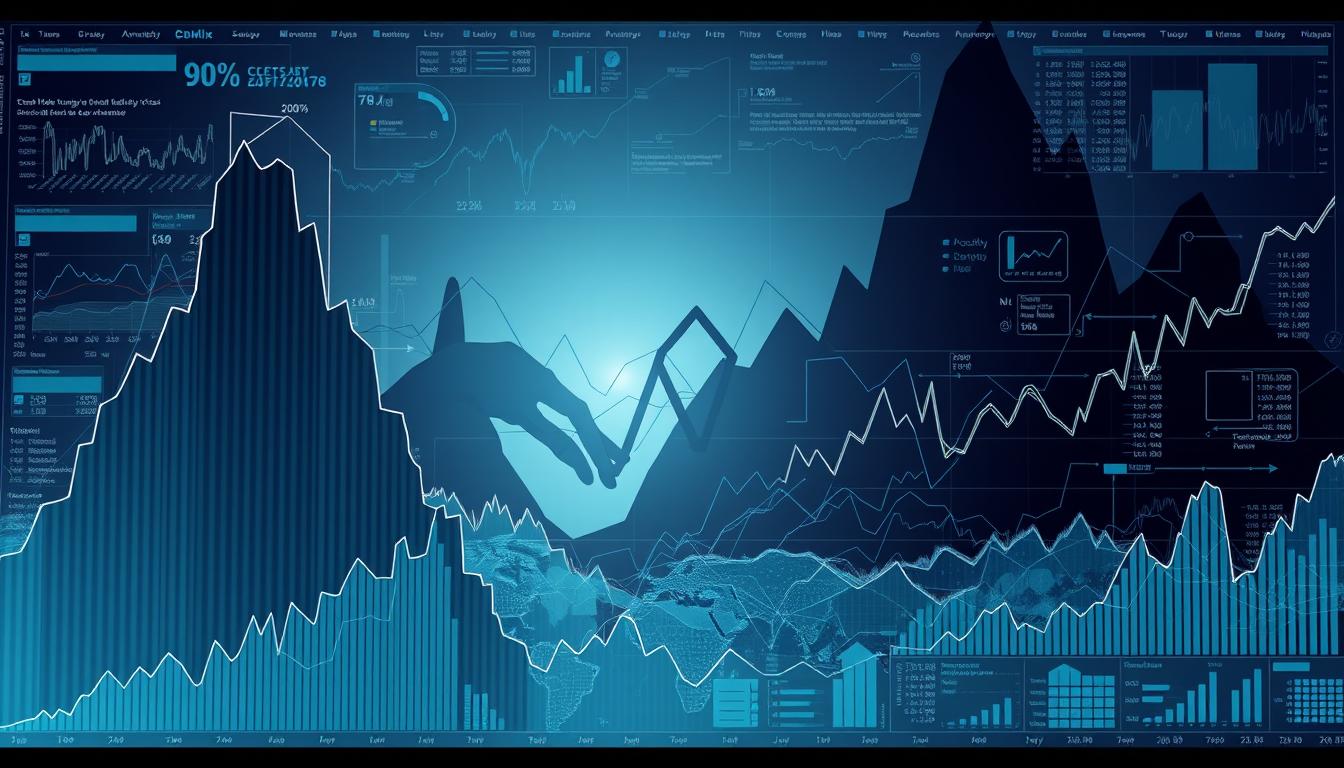Can a nation grow economically while facing financial collapse? The Turkish economy shows a puzzling mix of growth and danger. This has left many wondering.
The Turkish economy is in a tough spot. It deals with inflation, political instability, and currency fluctuations. These issues make its future uncertain.

Key Takeaways
- The Turkish economy faces significant challenges, including inflation and political instability.
- Currency fluctuations have played a critical role in the economy’s current state.
- Economic growth and collapse are closely linked in the Turkish economy.
- Recent economic data and trends are key to understanding the nation’s financial situation.
- The future of the Turkish economy is uncertain due to various factors.
The Current State of Turkey’s Economy
The Turkish economy is slowing down, causing worry among experts. Growth has dropped from 5.1% in 2023 to 3.2% in 2024.
Key Economic Indicators
Turkey’s economy shows mixed signs. Two key areas are GDP growth rates and unemployment figures.
GDP Growth Rates
Turkey’s GDP growth rate has been falling. This slowdown affects investment and jobs.
Unemployment Figures
The unemployment rate was 8.2% in February 2025. This shows a stable but tough job market. It’s a key sign of the economy’s job-creating power.
Recent Growth Patterns
Recent trends in Turkey’s economy are shaped by many factors. Domestic spending and trade play big roles. Yet, growth has been slow overall.
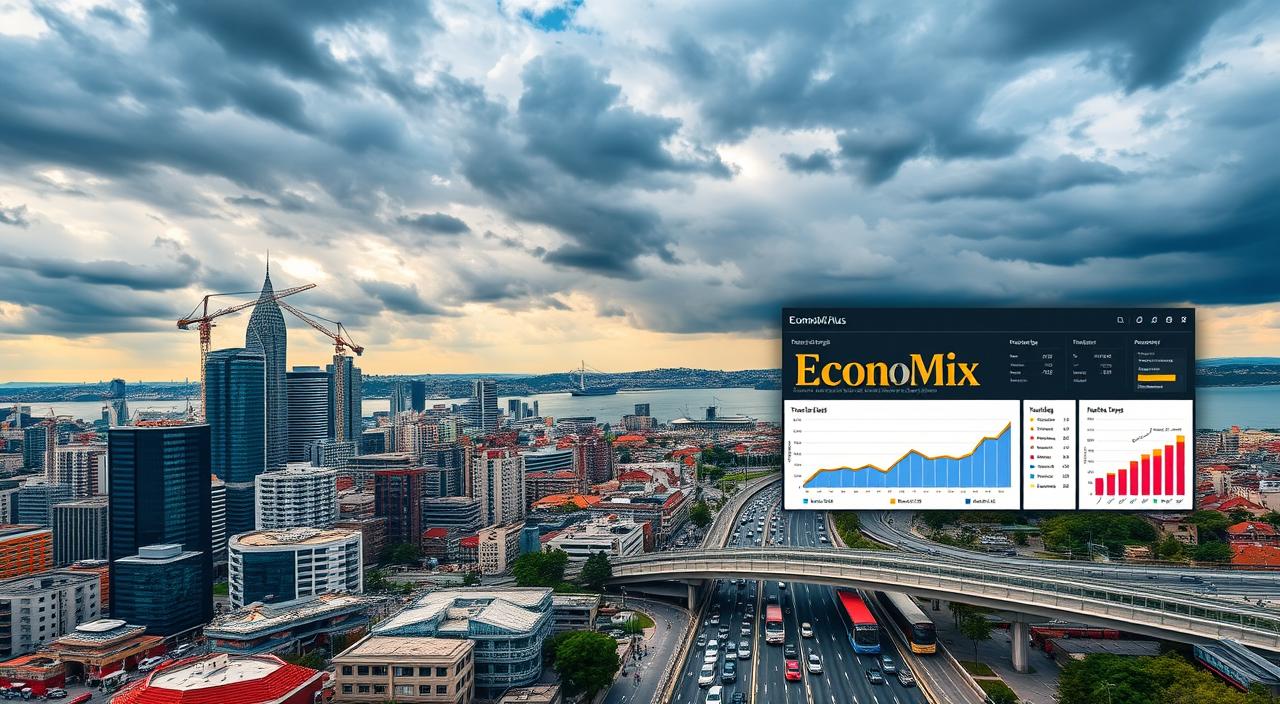
Warning Signs of Instability
Despite some good signs, Turkey’s economy faces instability. High inflation and currency shifts can hurt stability and investor trust.
To grow sustainably, Turkey must tackle these issues. Solving these problems is key to keeping the economy stable and promoting growth.
Historical Context: Turkey’s Economic Journey
To understand Turkey’s economy today, we must look back at key moments. The country’s economic path has been shaped by major events.
From Ottoman Empire to Modern Republic
Turkey’s economic story started with the Ottoman Empire. This vast state lasted from the 13th to the 20th century. The empire’s decline led to the creation of modern Turkey in 1923.
The early years of the republic were marked by a statist economic model. In this model, the state played a big role in economic growth.
Economic Liberalization in the 1980s
The 1980s were a turning point for Turkey’s economy. Turgut Özal’s government introduced reforms to open the economy to the world.
Turgut Özal’s Reforms
Turgut Özal’s reforms were key in changing Turkey’s economy. A famous economist said,
“Özal’s policies were a watershed moment in Turkish economic history, marking a shift towards a more liberal and export-oriented economy.”
His reforms included making trade freer, reducing state control, and encouraging foreign investment.
Opening to Global Markets
Opening Turkey’s economy to the world had a big impact. It led to more trade and investment, boosting growth.

New industries emerged, and old ones grew, making Turkey more important globally.
The 2001 Financial Crisis and Recovery
Despite progress, Turkey hit a severe financial crisis in 2001. The crisis led to big changes, like banking reforms and fiscal adjustments. The recovery efforts were successful, and Turkey’s economy bounced back, becoming more stable against future shocks.
Turkey’s economic journey is complex, shaped by history and policy. Knowing this history helps us understand its current economic situation.
The Erdogan Era: Economic Policies and Their Impact
Turkey’s economy under Recep Tayyip Erdogan has seen ups and downs. He has made many policy changes that have shaped the country’s economy.
Initial Economic Success (2003-2013)
Erdogan’s early years brought big economic reforms and investments. He focused on building infrastructure and attracting foreign investors.
Infrastructure Development
He started big projects like highways, airports, and public transport. These projects updated Turkey’s infrastructure, created jobs, and boosted the economy. The construction sector was a key driver of growth.
Foreign Investment Boom
Erdogan’s government made Turkey more appealing to foreign investors. They offered tax breaks and eased regulations. This led to a lot of foreign money coming in. Turkey’s location between Europe and the Middle East was a big draw for investors.
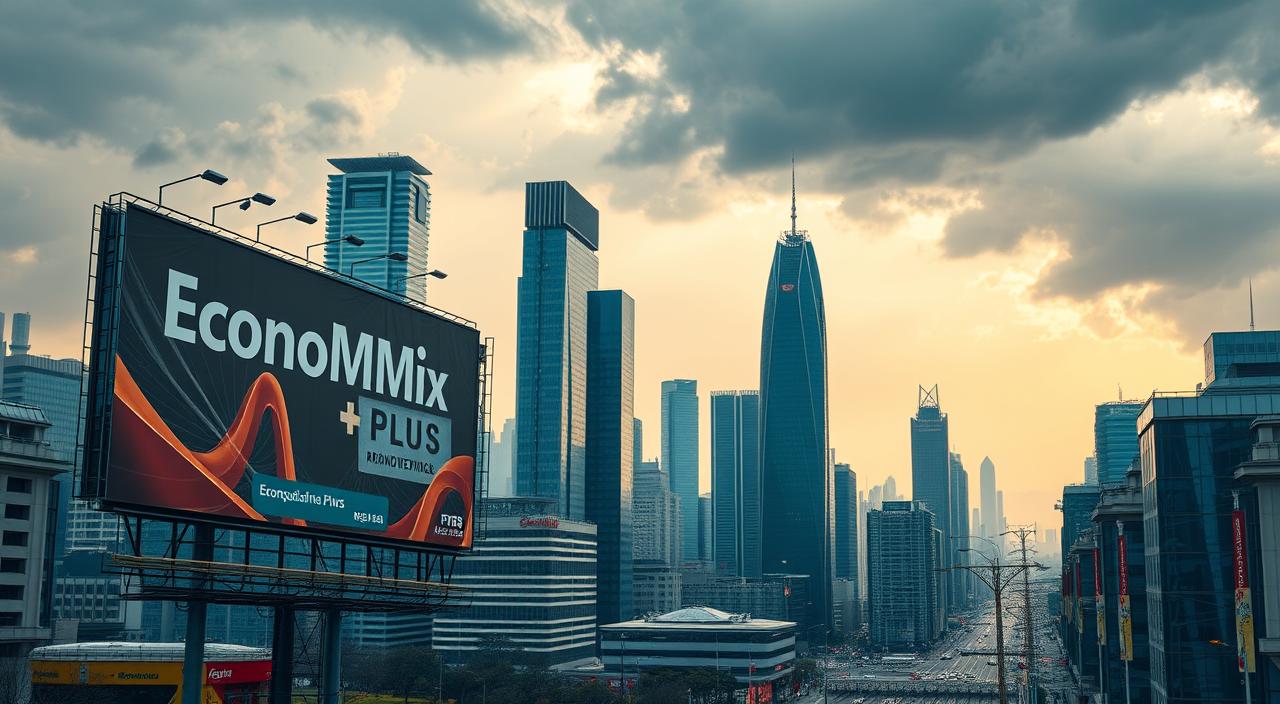
Shift Toward Authoritarian Economic Control
As Erdogan’s time in office went on, his control over the economy grew. He influenced finance, media, and energy more. This raised worries about democracy and the independence of regulators.
Unorthodox Monetary Policies
The end of Erdogan’s rule saw unusual money policies. These included interest rates and the central bank’s independence.
Interest Rate Controversies
Erdogan wanted lower interest rates to boost growth. This sometimes clashed with the central bank’s plans. The debate over rates added to economic uncertainty.
Central Bank Independence Issues
The central bank’s independence was often questioned. The government’s influence over it worried investors and experts. This raised concerns about inflation and currency stability.
The Erdogan era has seen both successes and challenges. Knowing how his policies affected Turkey’s economy is key to understanding its current and future state.
Turkey Between Economic Growth and Collapse – What’s Happening Now
The state of Turkey’s economy is full of contradictory signals. It shows both strength and weakness. Some sectors are growing fast, while others show signs of trouble.
Contradictory Economic Signals
Turkey’s economy has both good and bad news. It’s seeing growth in some areas but facing big challenges too. An economic analysis says, “Turkey’s economy is a mix of growth and risk, needing careful handling.”
Sectors Experiencing Growth
Several areas are boosting Turkey’s economy, including:
- Technology and Innovation: Turkey is investing a lot in tech, making big strides in fintech and software.
- Defense Industry: The defense sector is growing fast, thanks to local demand and global partnerships.
Technology and Innovation
The tech sector is a big driver of Turkey’s growth. It focuses on innovation, making Turkey a hotspot for startups, mainly in Istanbul. A tech expert says, “Turkey’s tech scene is booming, with a big push for R&D and new ideas.”
Defense Industry
Turkey’s defense sector has grown a lot, thanks to new tech in drones and missiles. This growth comes from more local investment and global partnerships.
Areas of Economic Vulnerability
Despite some growth, Turkey’s economy faces many risks. These include outside economic pressures, political instability, and internal economic issues. Fixing these problems is vital for lasting economic growth.
In short, Turkey’s economy is at a critical point. It has both chances and challenges. Finding a balance between growth and stability is essential for its future.
The Turkish Lira Crisis
Political interference and external pressures have led to the Turkish Lira crisis. The Lira’s value has been unstable, impacting Turkey’s economy in many ways.
Causes of Currency Devaluation
The Turkish Lira’s devaluation is due to several reasons. Political interference in monetary policy and external economic pressures are key factors.
Political Interference in Monetary Policy
The Central Bank of Turkey’s independence is often questioned. Political pressure on monetary policy has led to unusual measures. This has shaken investor confidence.
- Unorthodox interest rate policies
- Lack of clear monetary policy framework
- Impact on inflation expectations
External Economic Pressures
Global economic trends and geopolitical tensions have also affected the Lira. Economic sanctions and trade wars have hit the Lira’s value hard.
- Global economic slowdown
- Trade tensions with major economies
- Impact of geopolitical conflicts
Impact on Businesses and Consumers
The Lira’s devaluation has big effects on businesses and consumers. Rising import costs and increased inflation are major worries.
Businesses struggle with higher costs for imported goods and services. This can lead to higher prices for consumers. Consumers see their buying power drop.
Government Interventions and Their Effectiveness
The Turkish government has tried to stabilize the Lira. They’ve used foreign exchange interventions and monetary policy adjustments. But, how well these work is debated.
Some think these actions offer short-term relief. Others worry they could harm Turkey’s economy in the long run, like using up foreign reserves.
Inflation: The Silent Economic Killer
Inflation is quietly harming Turkey’s economy. It’s a complex issue that affects everyone. It has big impacts on the economy and people’s lives.
Historical Inflation Trends in Turkey
Turkey has long battled with high inflation. Knowing these trends helps us understand today’s economic state.
Current Inflation Rates and Their Causes
By March 2025, Turkey’s inflation rate dropped to 38%. This is down from a high of 75% in May 2024. Several factors have led to these high rates.
Supply Chain Disruptions
Supply chain problems have greatly increased inflation. Global events and logistical issues have raised costs for goods and services.
Monetary Policy Failures
Failed monetary policies have also fueled inflation. Unusual policies and poor control have made things worse.
Effects on Turkish Society and Business
Inflation’s effects are far-reaching, hitting both society and businesses.
Wage Erosion
Wages are losing value as inflation rises. This reduces the buying power of many Turks’ earnings.
Business Planning Challenges
Businesses face hurdles due to inflation. High rates make future planning uncertain.
Here are some key statistics:
- Inflation rate peaked at 75% in May 2024
- Eased to 38% by March 2025
- Significant effects on wage purchasing power and business planning
Economic experts warn, “High inflation rates can devastate an economy if not managed.” Good monetary policies and strong supply chains are key to fighting these effects.
Foreign Investment Landscape
In recent years, Turkey has seen changes in its foreign investment scene. These changes come from both inside and outside the country. Its spot between Europe and the Middle East makes it a great place for foreign investors.
Trends in Foreign Direct Investment
Foreign direct investment (FDI) in Turkey has been key to its growth. But, FDI has been hit by things like political stability and economic policy doubts.
According to recent data, FDI in Turkey has changed a lot. This shows how global and local economic trends mix together.
Investor Confidence and Risk Assessment
Investor trust in Turkey is shaped by many things. Political risk and economic policy doubts are big factors.
Political Risk Factors
Political risks, like policy changes or global tensions, really affect investor trust.
Economic Policy Uncertainty
Uncertainty in economic policies, like inflation or interest rate changes, also matters a lot to investors.
Government Initiatives to Attract Investment
The Turkish government has started many plans to draw in foreign investment. They offer incentives and work to make the business environment better.
| Initiative | Description | Impact |
|---|---|---|
| Incentives for Investors | Tax breaks and subsidies for foreign investors | Increased FDI inflows |
| Business Environment Improvement | Streamlining regulatory processes | Enhanced investor confidence |
These steps show the government’s dedication to making Turkey a better place for investment.
Tourism: Economic Lifeline or Vulnerable Sector?
Turkey’s tourism industry is a big help to the country’s economy. It brings in a lot of money and creates jobs. This makes tourism very important for Turkey’s economy.
Tourism’s Contribution to GDP
The tourism sector is a big part of Turkey’s GDP. It has been strong, bringing in millions of tourists from all over the world. This makes tourism a key part of Turkey’s economy.
| Year | Tourist Arrivals (Millions) | GDP Contribution (%) |
|---|---|---|
| 2018 | 40 | 4.2 |
| 2019 | 45 | 4.5 |
| 2020 | 15 | 2.1 |
| 2021 | 30 | 3.5 |
Recovery After COVID-19
The COVID-19 pandemic hit Turkey’s tourism hard. But, the sector is starting to get back on track. Turkey is now focusing on new markets and finding ways to adapt.
New Tourism Markets
Turkey is trying to attract tourists from the Middle East and Asia. This plan aims to lessen its reliance on European tourists.
Adaptation Strategies
The tourism industry is changing to meet new challenges. It’s improving health and safety and creating unique experiences for visitors.
Future Prospects and Challenges
Turkey’s tourism faces hurdles like global economic changes and political issues. But, it has a lot of room to grow. Investing in better infrastructure and marketing is key to keeping the recovery going.
Manufacturing and Export Sectors
The manufacturing and export sectors in Turkey have seen ups and downs. These changes come from both local policies and global trends. This mix affects different industries in different ways.
Key Manufacturing Industries
Turkey’s manufacturing scene is varied. It has many important sectors.
Automotive Sector
The automotive sector is a big deal in Turkey. It’s home to many international brands. This sector helps a lot with Turkey’s exports.
Textiles and Apparel
The textiles and apparel sector is also key in Turkey. It’s known for quality and good prices. It has a long history of success in exports.
Export Performance and Trade Balance
Many things affect Turkey’s exports, like global demand and trade deals. The trade balance shows how healthy Turkey’s economy is.
| Year | Export Value (Billion USD) | Trade Balance (Billion USD) |
|---|---|---|
| 2020 | 170 | -20 |
| 2021 | 190 | -15 |
| 2022 | 210 | -10 |
Competitiveness in Global Markets
Turkey’s manufacturing sectors have both chances and hurdles in the global market.
Cost Advantages
Turkey is cheaper to work in than many European countries. This makes it a good place for making things.
Quality and Innovation Challenges
Even with lower costs, Turkish makers must keep improving quality and coming up with new ideas. This is to stay ahead in the global market.
“The key to maintaining competitiveness lies in balancing cost efficiency with innovation and quality,” said a leading industry expert.
Banking Sector Health and Financial Stability
Looking at Turkey’s banking sector health tells us a lot about the country’s financial stability and future. The banking sector is key to Turkey’s economy. It supports financial transactions and economic activities.
Banking System Structure
Turkey’s banking system has different types of banks. This includes state-owned, private, and foreign banks. This mix makes the sector strong and competitive.
Key Components of Turkey’s Banking System:
- State-owned banks
- Private banks
- Foreign banks
- Participation banks (operating under Islamic banking principles)
Non-Performing Loans and Risk Exposure
Non-performing loans (NPLs) are a big worry for Turkey’s banks. If not handled right, NPLs can cause financial trouble.
Corporate Debt Issues
Corporate debt is growing, with many companies struggling to pay back loans. This has led to more NPLs.
Consumer Credit Risks
Consumer credit is also increasing, which could be risky if people can’t pay back. Banks must manage this risk well.
Data on Non-Performing Loans:
| Year | NPL Ratio (%) |
|---|---|
| 2020 | 3.5 |
| 2021 | 3.8 |
| 2022 | 4.2 |
Central Bank Policies and Independence
The Central Bank of the Republic of Turkey (CBRT) is key to keeping finances stable. Its independence is important for making good policies.
The central bank’s ability to make decisions without political interference is essential for maintaining financial stability and controlling inflation.
Regulators and investors closely watch Turkey’s banking sector. It’s very important for the country’s economic stability.
Geopolitical Factors Affecting Turkey’s Economy
Turkey sits between Europe and the Middle East, making its economy sensitive to many factors. Its strategic location is both a blessing and a curse. It plays a big role in regional and global affairs but faces many economic challenges.
Relations with the EU and NATO
Turkey’s ties with the European Union (EU) and the North Atlantic Treaty Organization (NATO) are key. These relationships impact Turkey’s economy in many ways. They affect trade, politics, and more.
Trade Agreements and Disputes
Turkey has been in a customs union with the EU for over 25 years. This has boosted trade between them. But, there have been disagreements over tariffs and rules.
Political Tensions and Economic Consequences
Political issues between Turkey and EU countries have hurt the economy. They’ve made investors nervous and cut down on trade.
Middle East Conflicts and Their Economic Impact
Turkey’s close location to Middle East conflicts has big economic effects. The country has been involved in many regional fights, which have shaken its economy.
| Conflict | Economic Impact |
|---|---|
| Syrian Civil War | Refugee crisis, increased military spending |
| Iraqi instability | Trade disruptions, security concerns |
Russia-Ukraine War Effects on Turkish Trade
The Russia-Ukraine conflict has hit Turkish trade hard. It’s affected Turkey’s energy needs and its agricultural trade.
Energy Dependency
Turkey depends a lot on imported energy. The conflict has changed how it buys energy, including its dealings with Russia.
Agricultural Trade Disruptions
The war has messed up global agricultural trade. This has hurt Turkey’s exports and imports of farm products.
Domestic Consumption and Middle Class Resilience
Domestic consumption and middle-class resilience are key to understanding Turkey’s economic health. Consumer spending plays a big role in Turkey’s economy. It’s influenced by policies, inflation, and global trends.
Consumer Spending Patterns
Consumer spending in Turkey varies. Essential spending, like food and housing, stays steady. But, discretionary spending, like travel, changes a lot.
Essential spending is driven by basic needs. On the other hand, discretionary spending depends on how confident people feel about the economy.
Essential vs. Discretionary Spending
The balance between essential and discretionary spending shows Turkey’s economic challenges. When times are uncertain, people spend more on basics and less on luxuries.
E-commerce Growth
E-commerce is changing how people shop in Turkey. Online shopping gives more choices and boosts the digital economy.
Middle Class Economic Pressure
The Turkish middle class faces economic challenges. Inflation, currency changes, and job issues affect them. This impacts how they spend and the economy’s stability.
Household Debt and Savings Rates
Household debt and savings rates show Turkey’s economic health. High debt means financial stress. Savings rates show if households can handle economic shocks.
Government Debt and Fiscal Policy Challenges
Turkey faces big challenges with government debt and fiscal policy. These issues greatly affect the country’s economic stability. Managing them well is key.
Public Debt Levels and Sustainability
Turkey’s public debt levels are a worry. Keeping this debt sustainable is vital for the economy’s health.
Domestic vs. Foreign Currency Debt
The mix of Turkey’s debt matters a lot. It affects how well the economy handles currency changes. Too much foreign currency debt can make things worse when currencies drop.
Debt Service Costs
Debt service costs are a big deal. They impact the government’s budget and its ability to fund important areas. High costs can cut into spending on public services and projects.
Budget Deficits and Government Spending
Budget deficits are a big challenge for Turkey’s finances. The government must find a balance between spending and income to reduce deficits.
- Revenue Enhancement: Better tax collection and less tax evasion can boost government income.
- Spending Rationalization: Focusing on key spending and cutting non-essential costs can help control deficits.
Tax Policy and Revenue Collection
Good tax policy is key for collecting revenue. Turkey must find a balance. It needs to encourage growth with tax breaks while making enough money for public spending.
The Path Forward: Growth Opportunities and Collapse Risks
Turkey’s economy is at a crossroads. It could see significant growth or face a major downturn. The direction it takes will depend on many factors.
Manufacturing and tourism are key drivers of Turkey’s economy. They have shown strength even when the world faces tough times. But, Turkey also has challenges like high inflation and currency issues. These can shake investor confidence.
Despite these risks, Turkey’s economy is diverse and strategically located. This helps reduce the chance of a complete collapse. Yet, the government must tackle public debt and keep finances in check to support long-term growth.
The future of Turkey’s economy hinges on the government’s strategy. They need to balance growth plans with careful economic management. They must also navigate the complex world of global trends and politics.
FAQ
▶
▶
▶
▶
▶
▶
▶
▶
▶
▶
▶
▶
▶
▶
